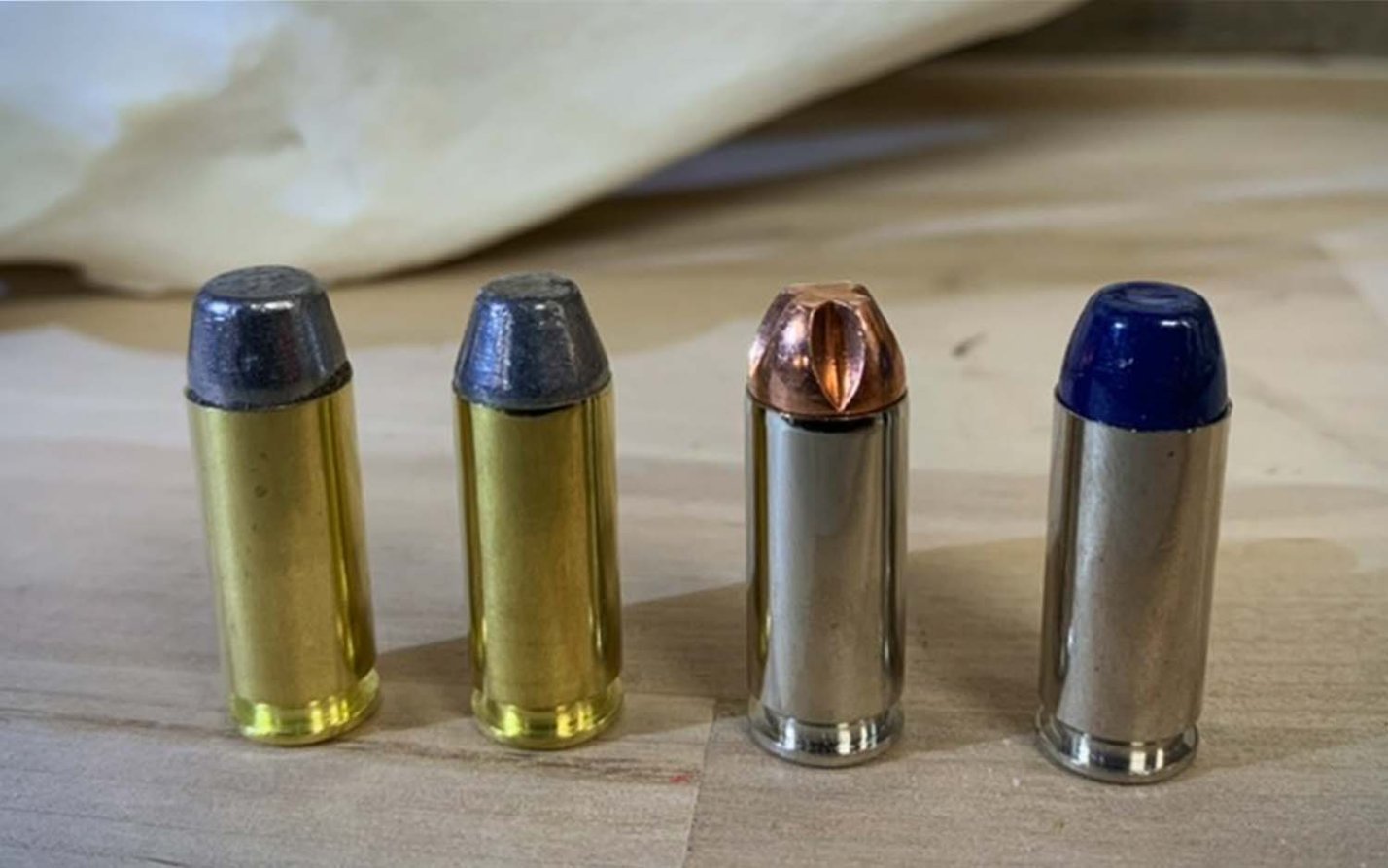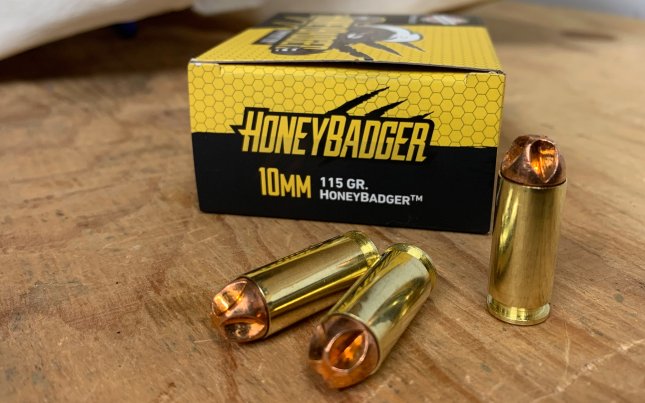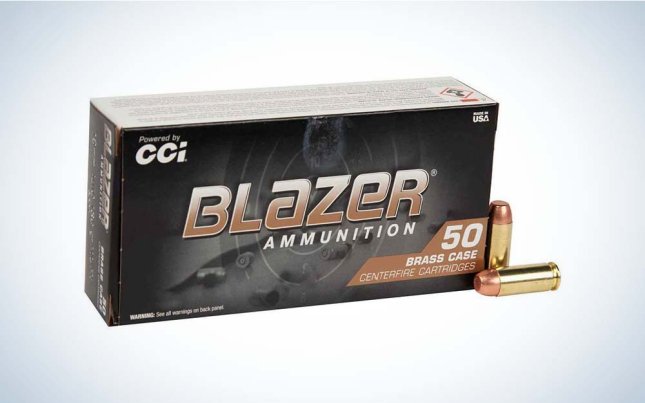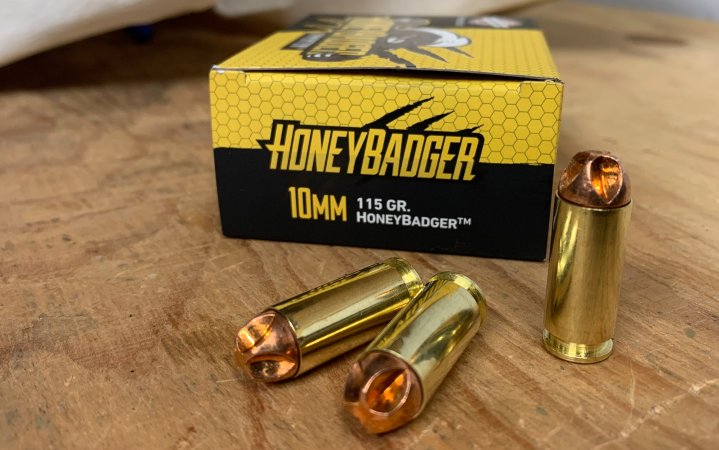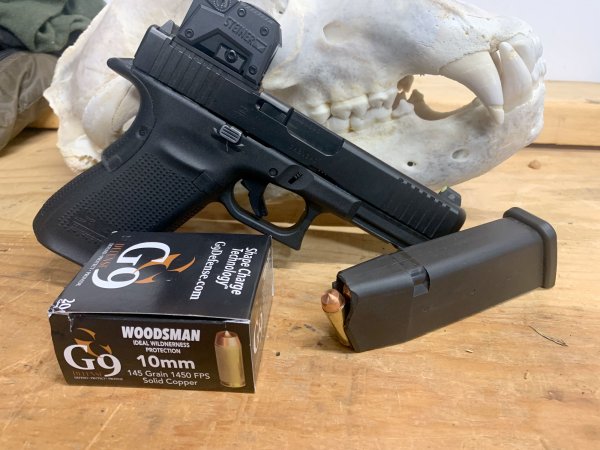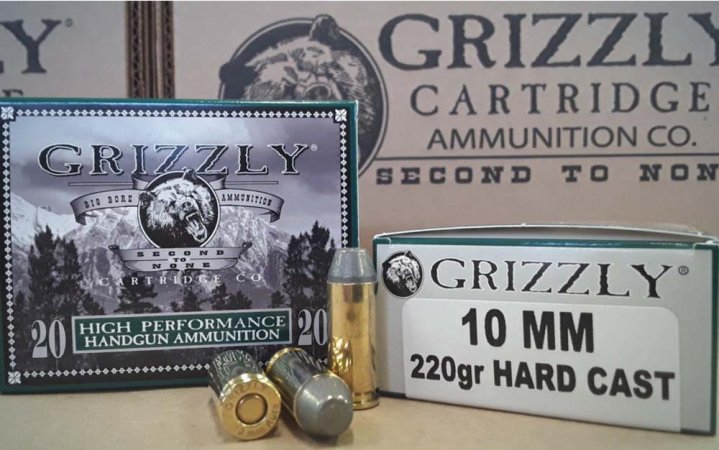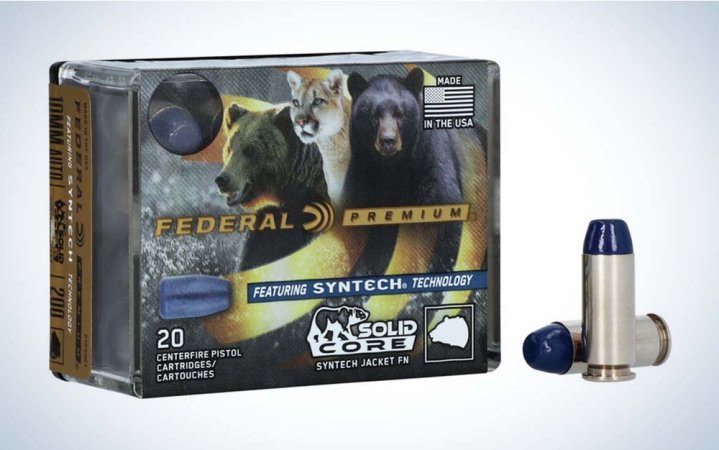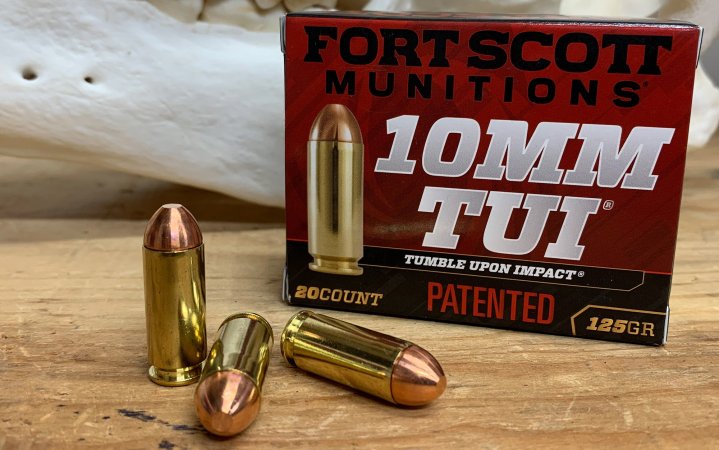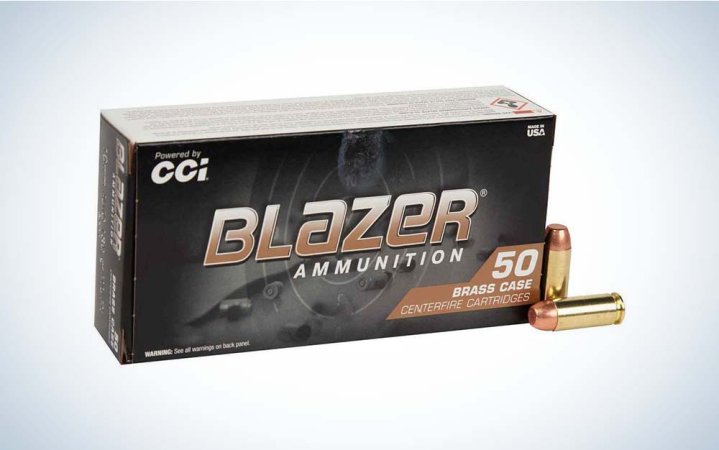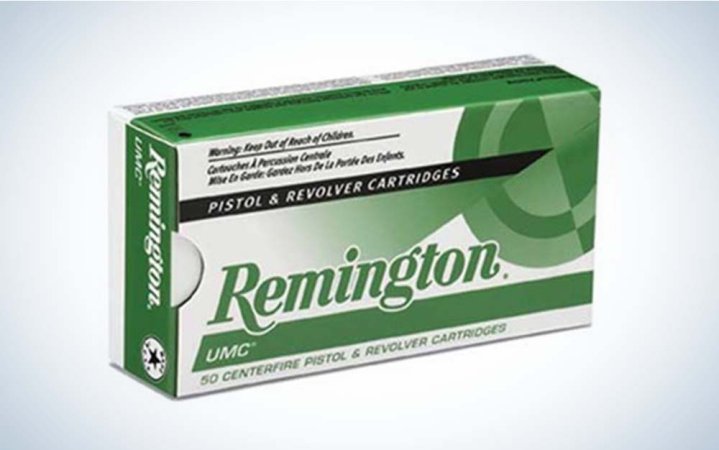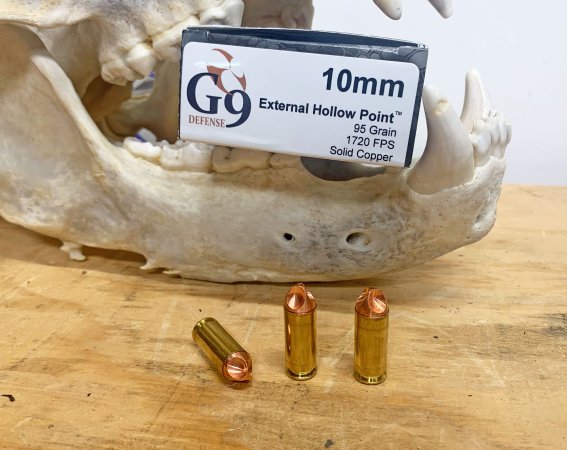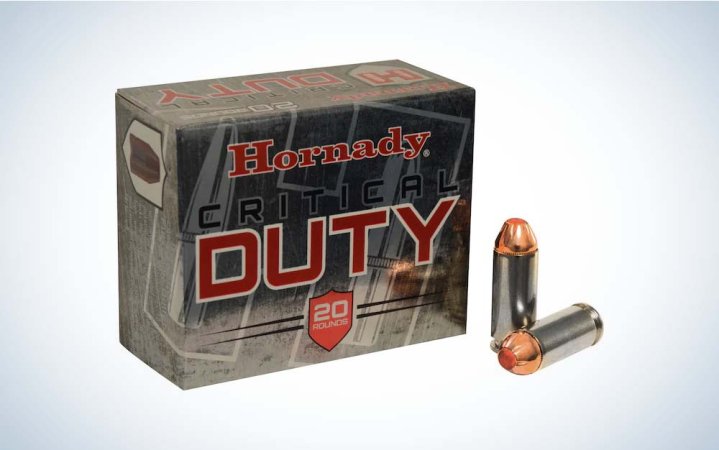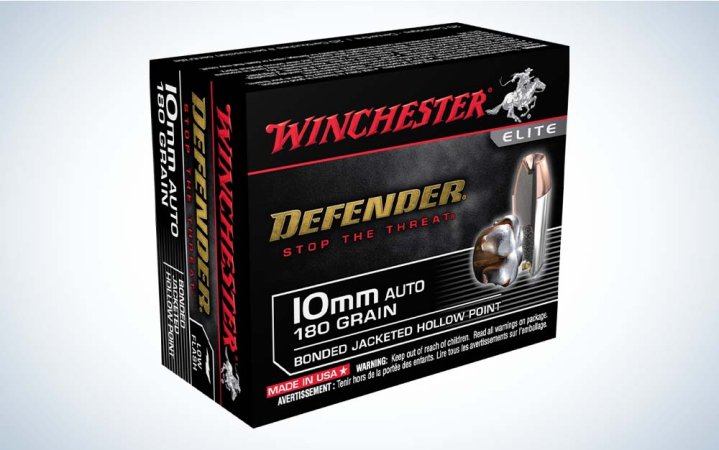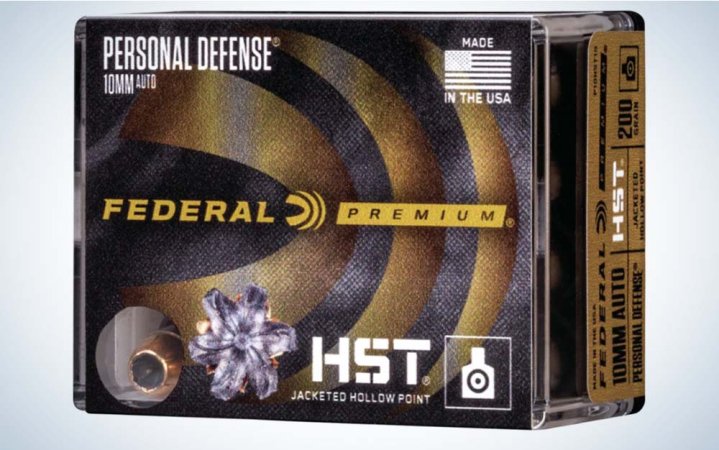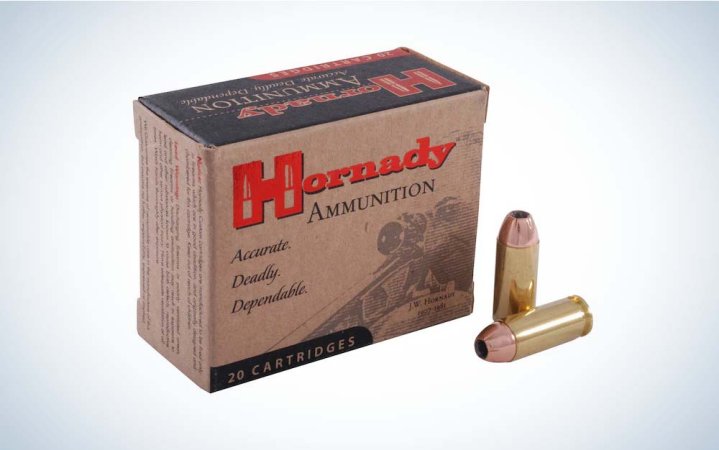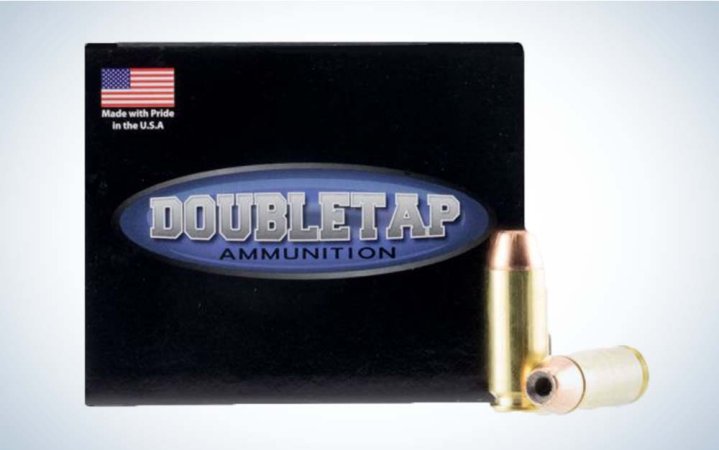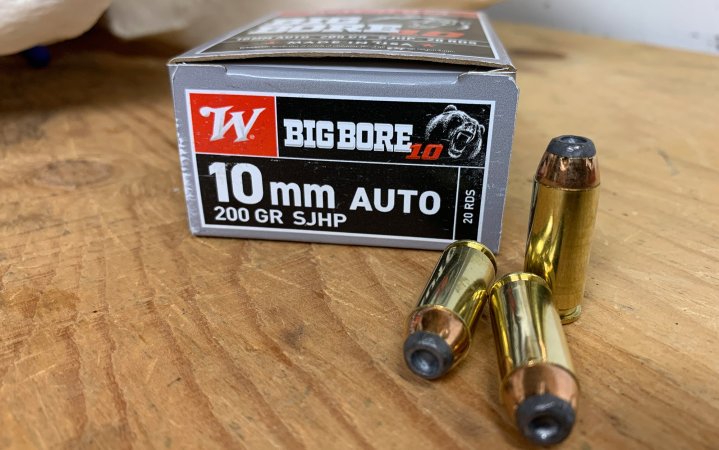We may earn revenue from the products available on this page and participate in affiliate programs. Learn More ›
First designed in 1983, the appeal of 10mm ammo fluctuated in its nearly 40-year lifespan; however, it might be at peak popularity right now. Whether you’re interested in hunting, defense, or target shooting, you’ll need the good 10mm ammo to get the most out of your handgun. I’ve used my 10mm for all those use cases and tested a pile of ammo over the years. I’ve been hunting and frequenting bear country in Alaska for 20 years, and started out carrying giant, heavy revolvers. I’ve switched to carrying a 10mm in recent years, and as a last resort, it has the capability of being an effective option for several applications. Here are my picks for the best 10mm ammo offerings that you might actually be able to find in stock.
Best for Bear Defense
- Black Hills Honeybadger 10mm
- G9 Defense Woodsman
- Buffalo Bore Heavy Outdoorsman 10mm 220-grain Hard Cast FN
- Underwood Ammo 10mm Auto 140-grain Xtreme Penetrator
- Grizzly Cartridge Company 10mm 200-grain Hard Cast
- HSM 10mm 200-grain Lead RNFP “Bear-Load”
- Federal Premium Solid Core Syntech 10mm 200-grain
- Fort Scott Munitions 125-grain TUI
Best for Practice
Best for Self Defense
- G9 Defense 95-grain External Hollowpoint
- Hornady Critical Duty 10mm Auto 175-grain FlexLock
- Winchester Defender 10mm Auto 180-grain Bonded JHP
- Sig Sauer Elite Performance 10mm Auto 180-grain V-Crown JHP
- Federal Premium 10mm Auto 200-grain HST JHP
Best for Hunting
- Hornady Handgun Hunter 10mm Auto 135-grain Monoflex
- Hornady Custom 10mm Auto 180-grain XTP
- Doubletap Ammunition 200-grain Controlled Expansion JHP
- Winchester Big Bore 10 200-grain SJHP
Why the 10mm Auto Is a Great Cartridge

A popular opinion is that the 10mm Auto is a capable cartridge for bear and other wildlife defense. That opinion isn’t based on the 10mm’s power—it’s certainly less powerful than a bushel of contemporary revolver cartridges—but rather because it brings an attractive balance between power and ease of use.
Cartridges like the .44 Magnum, .454 Casull, and even .500 S&W have long been touted as bear medicine, but they present some significant challenges to the shooter. Shooting handguns well requires lots of practice, and big revolvers often aren’t much fun to shoot. They also tend to be heavy, cumbersome, and annoying to carry in the field. Even ammunition price and availability play a role, and 10mm is generally cheaper and more readily available than most big revolver ammo.
Read Next: 9mm vs 10mm: Which Handgun Cartridge is Superior?
Pistols chambered in 10mm still have sharp recoil, but they are generally more serviceable to a wide variety of users. Some 10mm pistols are comfortable and compact enough to carry daily—as well as a backcountry defense gun. Many large revolver cartridges lose significant velocity when barrel lengths are shortened—due to slower-burning powders—but among all the 10mm loads listed, the difference in velocity from an extended 5-inch barrel and a compact 3.8-inch barrel averaged only 100 fps.
The variety of 10mm handguns and 10mm ammo is ever-increasing, and the cartridge is suitable for more than backcountry defense, but also some big-game hunting and everyday carry. One key to making the 10mm work for your intended application is to select appropriate ammunition. Selecting the wrong 10mm ammo for your intended use will greatly diminish its effectiveness.
Things to Consider Before Buying 10mm Ammo

The key to selecting the right 10mm ammo for you is to know your application.
- Will it be ammo for practice?
- Are you looking for bear defense ammo? Black bears or grizzlies?
- Are you going to be hunting whitetails?
- Will you use your 10mm for everyday carry and home defense?
- Can your handgun shoot cast lead bullets?
These questions are important ones to sort out, and they will determine what type and loads of 10mm ammo are best for you.
Many 10mm ammo options will give you similar results, and sometimes the ammo you pick will depend on availability or just personal preference. If you keep your intended purpose in mind, you can’t go wrong with anything on this list.
For example, if you’re looking for grizzly defense ammo, you don’t want personal defense hollow points. For animal defense, look for bullets that are non-expanding or minimally expanding and offer good penetration. For hunting, look for bullets that will expand and give good penetration. For EDC or personal defense against bad guys, focus on rapidly expanding hollow points that are designed for limited penetration. Of course, some options give you some overlap and are more versatile in their use.
Read Next: Springfield Armory XD-M Elite 3.8-inch Compact OSP 10mm w/Hex Dragonfly Review
Lead Bullets
Some of the most popular backcountry defense options for 10mm ammo utilize cast lead bullets because of their ability to penetrate with minimal expansion. If you search the internet, you’ll see a plethora of opinions and information regarding shooting these lead bullets in your handgun—some of it true, most of it false.
You can shoot lead bullets in pretty much any modern 10mm handgun, and it won’t blow up. Some barrels—like OEM Glock barrels—do tend to accumulate lead fouling much more rapidly than others. In theory, it can eventually cause pressure issues if you switch back and forth between jacketed and cast bullets, but you shouldn’t be alarmed. Simply make sure you clean the lead fouling out of your barrel after shooting cast bullets.
Best 10mm Ammo for Bear Defense: Reviews & Recommendations
Black Hills Ammunition 115-grain Honey Badger
Pros
- Low Recoil
- Good penetration, even through barriers
- Excellent wound cavity
Cons
- Less overall penetration than hard cast bullets
Key Features
- 115-grain Lehigh Defense Extreme Defense bullet
- Velocity: 1600fps (5-inch barrel)
- Monolithic construction, does not expand or deform
- Screwdriver-like fluting creates dramatic wound cavity
- Less recoil than heavier bullets
The development of monolithic bullets made from copper alloys has changed the game in several meaningful ways. Lehigh Defense has been at this task for a number of years, and their Extreme Penetrator and Extreme Defense handgun bullets have begun to see widespread use, and Black Hills Ammo has used them in many calibers in their Honey Badger line. Now, they’re offering it in 10mm, with a 115-grain Extreme Defense bullet. Other manufacturers have loaded the 140- and 150-grain extreme defense bullets, and I’ve handloaded them for years. The choice to go with 115-grain bullets seemed strange to me, until I talked to Jeff Hoffman of Black Hills Ammo, and he showed me photos from their gel tests.

What matters more than how much energy or mass a bullet has, is what it does to its target. We need bear defense rounds to penetrate well, and our non-expanding bullet choices have generally limited terminal performance. Loaded at 1,600 feet per second, however, the Black Hills 115-grain Honey Badger 10mm ammo produces a slightly larger and longer wound cavity in calibrated ballistic gel than a .44 Magnum shooting 240-grain JHPs. They penetrate approximately 20 inches with a temporary wound cavity diameter of 5 inches. Although .44 Mag. hard cast bullets will penetrate deeper, they will not create this kind of tissue disruption.
The Black Hills Honey Badger will give you approximately 1,600 feet per second out of a 5-inch barrel, but it’s about 1575 feet per second out of a standard Glock G20 4.6-inch barrel. Considering the low recoil and dramatic performance, this is one of the best options for backcountry defense 10mm ammo.
G9 Defense 145-grain Woodsman
Pros
- Low recoil, easy to shoot
- Great accuracy
- Great penetration
- Larger wound cavity than hard cast
- Good velocity
Cons
- Expensive
- Might need 5-inch barrel to match published velocity
Key Features
- 145-grain Monolithic Copper Bullet
- Truncated design with center spike to drive cavitation
- Velocity: 1,332 fps (measured with 4.6-inch Glock G20), 1,450 fps (box)
- Excellent hard barrier penetration and wound cavity
- Low recoil and excellent accuracy
Another excellent monolithic option for wilderness bear defense is the 145-grain Woodsman from G9 Defense. This monolithic copper slug has a truncated tip, but features a center spike with radius edges that sweep down to the flat point. This little feature causes dramatic cavitation in soft tissue, where flat-nosed slugs simply punch a wadcutter-like hole straight through. The end product is a high-velocity bullet that is great at punching through hide and bone, but inflicts a lot of tissue damage as well — something you want when trying to stop a toothy attacker. The lighter projectile weight results in less recoil than many other 10mm loads, and produces excellent accuracy. From my Gen 5 G20, it averaged 1.28-inch 5-shot groups at 15 yards, which is better than most defensive loads will produce.
Box velocity is published at 1,450 fps, but mine was a consistent 1,332 fps from my 4.6-inch-barreled Glock. A 5-inch, or longer, barrel would probably give you that extra push, but mid-1,300 fps is consistent with what I can get while loading 140- and 150-grain monolithic bullets safely, and it’s plenty to get the job done. With a shorter compact pistol, you’ll probably be looking at a still formidable 1,290 fps. The combination of shootability, penetration, and wound cavity is what will give you the best advantage possible, and this ammo delivers.

Buffalo Bore Heavy Outdoorsman 10mm 220-grain Hard Cast FN
Pros
- Heavy bullet weight
- Excellent penetration
- Good quality control
Cons
- Heavy recoil
- Increased fouling
Key Features
- 220-grain hard cast bullet
- Velocity: 1200 fps
- Energy: 703 foot-pounds
Buffalo Bore makes the best hard-cast 10mm ammo; it sets the standard to which all others are compared. The Heavy Outdoorsman squeezes the most velocity out of the heaviest bullet available for 10mm and is safe to shoot in any modern 10mm pistol. Of course with that exceptional performance comes exceptional recoil.
The hard-cast lead bullets won’t expand, and you won’t see hollowpoint-like terminal performance. This load is designed for one thing—penetration. In a bear defensive situation, you probably won’t be able to select a broadside shot, you need bullets that can penetrate skulls and other bones. The Heavy Outdoorsman 10mm load is said to achieve over 3 feet of penetration through soft tissue.
Read Next: Best Bear Defense Handguns
Underwood Ammo 10mm Auto 140-grain Xtreme Penetrator
Pros
- Great penetration
- Reduced recoil compared to heavier cast bullets
- Larger wound channel than cast bullets
- Shoots clean
Cons
- Less dramatic terminal performance than expanding bullets
Key Features
- 140-grain monolithic copper bullet
- Velocity: 1500 fps
- Energy: 700 foot-pounds
Using monolithic copper bullets made by Lehigh Defense, Underwood is another company that produces ammunition loaded to the top end of performance while remaining within SAAMI specifications for safe pressures.
The machined copper bullets are solid, but feature flutes cut from the point. The flutes reduce the surface area at the point and improve penetration but create cavitation and a wound channel more like an expanding bullet than those made by solid cast bullets.
The lighter copper bullets allow for higher velocities with less recoil and muzzle energy that equals or exceeds many lead-bullet loads. You might see slightly less penetration overall than with hard-cast loads, but it’s still exceptional.
Grizzly Cartridge Company 10mm 200-grain Hard Cast
Pros
- Heavy 220-grain cast bullet gets great penetration
- Quality Star-Line brass and other components
- Competitive price
Cons
- Lead fouling in bore
- Velocity may not match advertised
Key Features
- Bullet: 220-grain Hard-Cast
- Velocity: 1200 fps
- Energy: 703 foot-pounds
The 220-grain Hard Cast 10mm ammo from Grizzly Cartridge Company follows the popular recipe for animal defense—heavy-for-caliber bullets at higher velocity. Although heavy-recoiling, these bullets penetrate through heavy hide and bone.
As advertised, the velocity and energy match up with other close competitors, but the velocity I measured averaged 1135 feet-per-second out of a 5-inch barrel—slightly slower than advertised. Velocity will vary slightly from gun to gun, and it’s a small enough difference that I wouldn’t pay it much mind.
HSM 10mm 200-grain Lead RNFP “Bear-Load”
Pros
- Good penetration
- Slightly less recoil than 220-grain loads
- Usually cheaper than similar options
Cons
- Lead fouling in barrel
- Smaller wound cavity than expanding bullets
Key Features
- Bullet: 200-grain hard-cast lead
- Velocity: 1041
- Energy: 481 foot-pounds
The 200-grain “Bear-Load” from HSM is a simple hard-cast lead bullet that provides great penetration through bone and hide. It often retails cheaper than some other common hard-cast options, but uses premium Star-Line brass.
HSM advertises muzzle velocity at 1041 fps, but I measured it at about 1160 fps from a 5-inch barrel and 1090 fps from a 3.8-inch barrel. Actual muzzle energy will also be slightly higher than advertised with those velocities. It’s a simple load but an excellent option for the backcountry.
Federal Premium Solid Core Syntech 10mm 200-grain
Pros
- Nickel-plated cases for reliable feeding
- Hard Lead core for excellent penetration
- Syntech coating reduces lead fouling
Cons
- Terminal performance not as dramatic as expanding bullets
Key Features
- 200-grain Syntech-coated lead bullet
- Velocity: 1200 fps
- Energy: 639 foot-pounds
One of the most common complaints about hard-cast lead bullets is that they tend to foul barrels—especially in Glocks. In addition to leaving soft lead fouling in your barrel, cast lead bullets tend to be smokey when shooting. This ammunition solves both those problems by coating a hard lead core with Federal’s Syntech coating.
The 200-grain lead bullets don’t push pressure boundaries, but at 1200 fps, they still offer great penetration and manageable recoil. Nickel-plated cases aid with reliable feeding, and this premium ammo will work when you need it to. You’ll get too much penetration for it to be a great EDC load, but it’s a good option in the woods.
Fort Scott Munitions 125-grain TUI
Fort Scott Munitions 125-grain TUI
Pros
- Low Recoil
- Great penetration, even on hard barriers
- Good wound cavity
Cons
- Light bullet doesn’t penetrate as far as hard cast
Key Features
- 125-grain copper spun solid bullet
- Velocity: 1,600 fps (4.6-inch barrel)
- Monolithic construction, does not expand or deform
- Designed to tumble after impact
- Low recoil
The downside of using heavy, deep-penetrating solid bullets is that they sacrifice terminal performance. Lighter monolithic bullets driven at high speed can penetrate bone and produce larger wound cavities, and Fort Scott Munitions has a unique take on it with their 125-grain TUI (tumble upon impact) load. It features a “solid copper spun” bullet that draws to a point at the front. As expressed in the name, the projectile is designed to create its wound cavity by tumbling after impact.
The 125-grain bullet exits the muzzle at 1600 feet per second—blistering speed for the 10mm. Velocity averaged 1,607 feet per second out of my Glock G20. Although tumbling will certainly shorten overall penetration, this load strikes a good balance between penetration and the large wound channel it creates. I fired the Fort Scott Munitions 125-grain TUI through a test jig consisting of doubled-up 2×4’s, 3 inches thick, followed by four gallon water jugs. The bullets consistently drove a straight path through the boards then tumbled through all four jugs. That’s good enough for me.
Read Next: Smith & Wesson M&P M2.0 10mm 4-Inch Review
Best 10mm Ammo for Practice: Reviews & Recommendations
CCI Blazer Brass-case 10mm Auto 180-grain FMJ FN
Pros
- Cheaper than premium defense loads
- Bullet weight and velocity provide realistic recoil and practice
- Could be used in animal-defense applications
Cons
- Not specialized for any defensive application
Key Features
- Bullet: 180-grain full metal jacket flat nose
- Velocity: 1200 fps
- Energy: 576 foot-pounds
Blazer Brass 10mm ammo is the best 10mm ammo for the range. It features reloadable brass that accepts small-pistol primers—some manufacturers are doing this rather than using large pistol primers. The bullet is a simple 180-grain full metal jacket that won’t expand and isn’t much good for hunting.
This is primarily practice ammo sold in 50-round boxes and is more affordable than premium loads—typically sold in boxes of 20. In a pinch, it could be thrust into animal-defense applications, but it’s not the best option.
Remington UMC 10mm Auto 180-grain FMJ
Pros
- Competitively priced and reasonable availability
- Less recoil than heavy defense loads
- Reloadable nickel-plated cases
Cons
- Only ideal for practice and target shooting
Key Features
- Bullet: 180-grain Full Metal Jacket
- Velocity: 1150 fps
- Energy: 529 foot-pounds
Remington UMC ammo has long been a staple for range and practice pistol ammo, and under new ownership, they’re back in business. This simple load features nickel-plated, reloadable, large-primer cases, as well as a bronze-colored full-metal-jacket bullet.
This load’s velocity (and recoil) is a little below some other target loads, but it’s still a 10mm, and will help shooters build their skills at a more affordable rate. Since coming under new ownership, Remington ammo has been cranking out ammo full speed and It’s been getting to the shelves in many areas.
Best 10mm Ammo for Self Defense: Reviews & Recommendations
G9 Defense 95-grain External Hollowpoint
Pros
- Low Recoil
- Great barrier penetration
- Excellent wound cavity
- Accurate
Cons
- Expensive
Key Features
- 95-grain fluted monolithic bullet
- Velocity: 1758 fps (4.6-inch barrel)
- Monolithic construction, does not expand or deform
- Fluting creates dramatic wound cavity at high velocity
- Less recoil than heavier bullets
Modern monolithic bullet designs with external fluting are a great option for bear defense, but they make a superb defensive round against bad guys too. This new option from G9 Defense, called the external hollowpoint, features three deep, rounded flutes and a rounded profile. It’s a 95-grain bullet spitting out at an advertised 1720 fps, and I found that in my Glock G20 Gen 5 MOS, it produced slightly higher speeds of 1758fps. In the shorter 3.8-inch-barreled Springfield XD-M Compact, it averaged 1718 fps. That velocity drives the light monolithic bullet through hard barriers, and the flutes produce wound channels much more dramatic than a solid hard-cast bullet can. They truly behave as a hollowpoint in that fashion, losing steam after about 18 inches of penetration — ideal to avoid over penetration in a defensive situation.
This ammunition proved to be quite accurate when tested in my G20. Four five-shot groups averaged 1.190 inches at 15 yards. It’s some of the lightest recoiling 10mm ammo I’ve ever shot, and would give me full confidence in taking quick, accurate shots in a stressful situation.

Hornady Critical Duty 10mm Auto 175-grain FlexLock
Pros
- Rapid, controlled expansion
- FlexLock tip prevents clogging
- Interlock band aids with weight retention
- Low-flash propellant for low-light situations
Cons
- Penetration characteristics not ideal for animal defense
Key Features
- Bullet: 175-grain FlexLock
- Velocity: 1160 fps
- Energy: 523 foot-pounds
Numerous law enforcement agencies use Hornady’s Critical Duty line, and in 10mm, it’s a proven performer in FBI ballistics testing. Velocity and energy aren’t exceptionally high, but raw penetration isn’t the goal for general defensive ammo. Nickel-plated cases aid in smooth feeding, and the FlexLock tip aids in consistent expansion, even after passing through a variety of standard barriers.
The best 10mm ammo for self-defense expands reliably while maintaining its weight without excessive penetration. It wouldn’t be a bad option for hunting deer-sized game or smaller, especially with careful shot selection. It’s not a great option for bear defense or for large game.
Winchester Defender 10mm Auto 180-grain Bonded JHP
Pros
- Rapid expansion up to 1.5x original diameter
- High weight retention
- Low flash
- Great for EDC and hunting light game
Cons
- Less penetration than non-expanding bullets
Key Features
- Bullet: 180-grain Bonded Jacketed Hollow Point
- Velocity: 1240
- Energy: 614 foot-pounds
This defensive load from Winchester features nickel-plated cases and a jacketed hollowpoint that’s bonded for maximum weight retention. The cup of the hollow point is open, but the bullet jacket’s edges are scored for uniform expansion.
This 10mm ammo utilizes low-flash powder for potential low-light defensive situations and produces a good balance of velocity and recoil. It’s primarily intended for EDC-type applications, but it would make a suitable hunting bullet on lighter game.
Sig Sauer Elite Performance 10mm Auto 180-grain V-Crown JHP
Pros
- Rapid, dramatic, uniform expansion
- Optimal penetration for EDC applications
- Premium components for reliability
- Reduced recoil from heavier bullets
Cons
- Not optimal for animal defense applications
Key Features
- Bullet: 180-grain V-Crown JHP
- Velocity: 1250 fps
- Energy: 624 foot-pounds
Sig’s V-Crown JHP loads are one of the top EDC-type loads in general, and this offering brings it to the 10mm auto platform. Like many other 10mm loads, it’s a 180-grain Jacketed hollow point, but the V-Crown is known for its reliable flower-petal-like expansion.
Velocity and energy levels are on-par with most full-power 180-grain loads, and the ammunition functions well in compact handguns. It would work for some light-game hunting applications such as whitetail deer, but this ammunition is designed for expansion and limited penetration.
Federal Premium 10mm Auto 200-grain HST JHP
Pros
- Consistent, rapid expansion
- Good barrier penetration with limited overall penetration
- Heavier than most defensive bullets
Cons
- Heavier recoil than other EDC loads
Key Features
- Bullet: 200-grain HST Jacketed Hollowpoint
- Velocity: 1130 fps
- Energy: 567 foot-pounds
The HST is one of the most popular service and personal defense bullets on the market. It gives rapid, dramatic expansion, with high weight retention and good initial barrier penetration. In 10mm, it’s a great option for everyday carry. The 200-grain HST is heavier than most 10mm defensive hollow point loads and is designed to deliver maximum energy transfer without over-penetration.
Like some other 10mm ammo, this load uses nickel-plated brass that uses small primers, and quality of components is excellent. Velocities are consistent, and I measured them as averaging slightly higher than advertised. Recoil is significant, but hey, it’s a 10mm. This load would work in hunting applications for whitetail-sized game, but don’t expect tons of penetration.
Best 10mm Ammo for Hunting: Reviews & Recommendations
Hornady Handgun Hunter 10mm Auto 135-grain Monoflex
Pros
- Lead free
- High velocity with lower recoil
- Rapid expansion with good penetration
- Good for both hunting and EDC applications
Cons
- Rapid expansion not great for animal defense application
- Lighter bullet might not penetrate as well on less-ideal shot angles
Key Features
- Bullet: 135-grain Monoflex monolithic copper hollow point
- Velocity: 1315 fps
- Energy: 518 foot-pounds
This lead-free 10mm ammo features a traditional-looking hollow point that is filled with the proprietary Monoflex material. This soft rubbery material helps prevent the hollow point from clogging, and—when compressed upon impact—aids with rapid, uniform expansion of the bullet.
Since there’s no jacket to separate, the bullet retains nearly all its weight. This aids in penetration, but although the rapid expansion makes for great terminal performance, overall penetration will be limited.
The performance characteristics and construction make it a great option for hunting—especially where lead-free is a requirement—and the reduced recoil also makes this an appealing everyday carry option.

Hornady Custom 10mm Auto 180-grain XTP
Pros
- Rapid initial expansion, but good penetration
- Consistent velocities
- Great all-around bullet
Cons
- Might over-penetrate in EDC applications
Key Features
- Bullet 180-grain XTP JHP
- Velocity: 1275 fps
- Energy: 650 foot-pounds
The XTP is a well-established bullet, and a great hunting option for 10mm ammo. The jacketed hollow point has a smaller-diameter opening than other points, but the segmented jacket gives pretty consistent expansion to a point.
The XTPs don’t open up to the diameter that some other hollow point bullets will, but in turn, they penetrate really well for a hollow point. Their penetration might be more than ideal for an EDC load, but it’s not what you’ll see in a heavier solid bullet. It would be a suitable bullet for animal defense if you don’t have grizzly bears in mind.
Read Next: 10mm vs 45 ACP: Which Auto is Best?
DoubleTap Ammunition 200-grain Controlled Expansion JHP
Pros
- Better penetration than many other hollow points
- Larger wound cavity
- Over 1200 fps in 5-inch barrels
- Good defensive and general-purpose load
Cons
- Penetration is more than ideal for EDC applications
- Not suitable for grizzly bears
Key Features
- Bullet: 200 grain custom jacketed hollow point
- Velocity: 1195 fps
- Energy: 634 foot-pounds
DoubleTap Ammunition is known for producing quality, high-performance handgun loads, and this 10mm ammo is one of the best options for hunting out there. Their custom 200-grain JHP controlled-expansion bullet expands to 0.74 inches, nearly doubling in diameter. It’s designed to penetrate 20 inches and defeat heavy hide and bone. The increased penetration relative to some other hollow points make this a feasible—and even favorable—load for defense and general use when you won’t be dealing with grizzly bears. They would certainly work for EDC applications as well, but with an increased risk of over penetration. DoubleTap loads with tight tolerances and attention to detail, and this is one of the best hunting options available in a factory load.
Winchester Big Bore 10 200-grain SJHP
Winchester Big Bore 10 200-grain SJHP
Pros
- Controlled expansion
- Good penetration for hollowpoint
- Good hunting and defense bullet
Cons
- Soft point might limit penetration through bone
Key Features
- 200-grain semi-jacketed hollowpoint
- Velocity: 1,175 feet per second (4.6-inch barrel)
- Controlled expansion
- Full 10mm power
Winchester’s new Big Bore line includes this 200-grain option for the 10mm. It’s a full-power load that pushes a 200-grain semi-jacketed hollow point at 1,175 feet per second out of a standard-sized pistol. This is a great option for hunting and bear defense because the limited expansion on the bullet creates trauma but still penetrates deeply. Winchester’s testing showed it to penetrate over 30 inches of ballistic gel. The semi-jacketed bullet has a lead point, and the hollow point is shallow, unlike personal defense loads. The lead tip of the bullet is designed to expand only slightly, to create cavitation and a bigger wound channel than solid hard-cast bullets.

Although it likely won’t penetrate bone as well as hard cast or other solid bullets, The Big Bore load is a great all-around option that will still punch through a bear’s skull with little fuss. It would make a great hunting bullet for deer, hogs, or other medium-sized game as well.
Read Next: Best 9mm Ammo
FAQs
Generally, the best 10mm ammo for bear defense will have a deep penetrating and minimally expanding bullet. There are several great loads available with hard cast, monolithic copper, and jacketed bullets. Steer clear of hollow points that are designed for dramatic expansion.
Although what you consider “expensive” depends on your personal budget, 10mm ammo is generally priced higher than 9mm ammo. You can expect to find range/practice ammo for around 50 to 60 cents per round, and premium defensive ammo for $2 or more per round.
Since the 10mm cartridge has become much more popular in recent years, ammo usually isn’t hard to find. Lots of people shoot it, but not at the volume that folks consume 9mm ammo. Throughout the current ammo shortage, 10mm has been steadily available in most places.
Some 10mm ammo that’s intended for range and target practice is loaded light, and 180-grain FMJ loads with velocities between 1,000 and 1,100 feet per second match the ballistics of the .40 Su0026W. In fact, the .40 Su0026W was derived from these reduced recoil loads and simply uses a shorter case. Pretty much any of the premium defensive 10mm ammo you’ll see on the shelf is “full power.”
Every situation is different, but the 10mm cartridge is capable of stopping a grizzly bear with well-placed shots. There are lots of examples of it happening. No handgun can be counted on to stop a bear in every scenario, but the 10mm provides a good balance of power and shootability.
Read Next: The 4 Rules of Gun Safety
Final Thoughts
The most important part of selecting the best 10mm ammo is to keep in mind your intended application and the limitations of the caliber. Most people will be looking to use it primarily for animal defense (and it’s a good choice) but remember, it’s not magic, and it can’t do everything. Among the most important things is to buy lots of practice ammo and shoot often.
